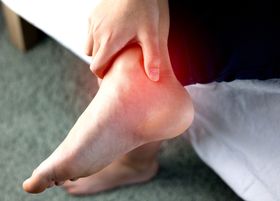Stretch Your Way to Patellar Tendonitis Relief
Updated November 14, 2023
Are you experiencing knee pain after your latest workout or sports activity? You might be suffering from patellar tendonitis, a common condition that is often dubbed "jumper's knee."
The symptoms of patellar tendonitis are hard to ignore. You might feel pain and tenderness, experience swelling in the front of the knee, and notice stiffness and weakness. These symptoms often worsen with physical activity and improve with rest. If these sound familiar, don't worry—there's a practical solution at your fingertips: stretching!
While rest, ice, and physical therapy are commonly recommended interventions, incorporating specific patellar tendonitis stretches into your daily routine can offer significant pain relief and prevent further injury. Ready to learn some effective stretches to combat patellar tendonitis? Let's dive in!
Best Stretches for Patellar Tendonitis
- Quadriceps Stretch
- Wall Calf Stretch
- Kneeling Hip Flexor Stretch
- Seated Toe Touch
- Hamstring Stretch
Quadriceps Stretch
Tight thigh muscles, or quadriceps, can increase the strain on your patellar tendon, causing more knee pain. The quadriceps stretch actively targets these muscles, improving your knee's flexibility and reducing pain.
Here's how to perform it: Stand facing a wall or chair for balance. Bend one knee and grasp your ankle with the same hand. Pull your heel towards your buttocks until you feel a stretch in the front of your thigh. Remember to tighten your core and keep your knees close together to avoid straining the knee joint. Hold the stretch for about 30 seconds and repeat on the other side.
Did you know?
Patellar tendonitis is typically caused by overuse or repetitive stress on the patellar tendon, leading to tiny tears and subsequent inflammation. It can also occur due to a sudden increase in activity level, improper technique, or biomechanical abnormalities in the knee joint.
Wall Calf Stretch
Tight calf muscles can also place additional strain on the patellar tendon, leading to inflammation and pain. The wall calf stretch is designed to alleviate pain by targeting any tight calf muscles, reducing the tension on the patellar tendon, and improving the overall flexibility of your lower leg muscles.
Here's how to do it: Stand facing a wall with your hands on the wall for support at eye level. Place one foot in front of the other, with the foot to be stretched behind. Ensure your back leg is straight and your heel is on the ground. Slowly lean forward, bending your front knee. You should feel a stretch in the calf muscle of your back leg. Hold this position for 30 seconds, then release and repeat on the other leg.
» Having knee trouble? Here are the best exercises for knee arthritis
Kneeling Hip Flexor Stretch
Adding the kneeling hip flexor stretch into your daily routine can be a great way to alleviate pain associated with patellar tendonitis. The kneeling hip flexor stretch targets the hip flexor muscles located at the front of the hip, helping improve the flexibility of the muscles, leading to reduced pain and discomfort in your knee joint.
Here's how you can perform the kneeling hip flexor stretch:
- Kneel on a mat or any soft surface and place one leg forward and the other knee on the ground behind you, forming a 90-degree angle at the hip and knee.
- Slowly lean forward onto the front leg until you feel a comfortable stretch in the hip of the rear leg. Place your hands on the front knee for support if necessary.
- Maintain the stretch position for 20-30 seconds and then release. Repeat on the other side.
» Find out if orthotic insoles can help with knee pain
Seated Toe Touch
The seated toe touch stretch increases the flexibility of the muscles of your lower back and hamstrings. This reduces the strain on the knee joint and enhances your overall mobility.
Here's how you do it: Sit on the ground with your legs extended in front of you, back straight, and feet flexed. Reach toward one foot with both hands. If you can't touch your toes, no problem! You can reach for your ankles or shins instead. Do this until you feel a stretch in the back of your leg and your lower back. Hold the stretch for 20-30 seconds, then release and alternate between your two legs.
» Does your knee hurt when squatting? Here's how to fix it
Hamstring Stretch
Tight hamstrings can also contribute to patellar tendonitis. By stretching the hamstrings, you can help reduce the strain on the knee joint and improve overall mobility.
To perform the hamstring stretch:
- Lie on the floor near the outer corner of a door frame.
- Raise one leg and rest the heel of the same leg against the wall.
- Slowly straighten your lifted leg until you feel a stretch in the back of your thigh.
- Hold the stretch for 30 seconds.
- Switch legs and repeat as many times as possible.
Say Goodbye to Knee Pain
Incorporating these five stretches into your daily routine can significantly alleviate the pain associated with patellar tendonitis. Regular practice can prevent further knee injuries and improve your flexibility.
For more comprehensive pain relief, consider complementing these exercises with Upstep's Multi-Sports Custom Orthotics. These custom-made orthotics provide additional support and shock absorption, reducing the impact of movement on the knees and helping to prevent further damage to the patellar tendon.








